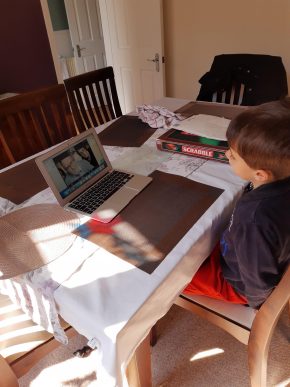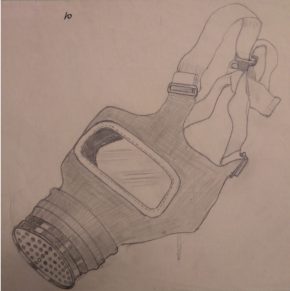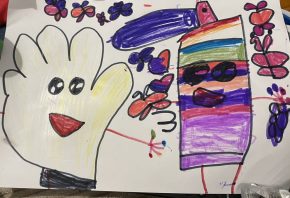How do you turn research data into the Young V&A‘s first online exhibition? This was the challenge I faced in September 2021, when I started as Online Exhibition Producer for the Play in the Pandemic exhibition. I had six months to devise and deliver an online exhibition that would examine the importance of play and showcase the artworks, games and experiences of children during the pandemic in 2020-22.
As with all exhibitions, I began with the objects, which in this case were the digital submissions, sent in from parents and their children, to an online survey devised by UCL and University of Sheffield at the Play Observatory. This survey called for examples of children’s play during the pandemic. Its aim was to create a publicly accessible database to explore if or how the pandemic impacted on children’s play.
There were 100s of submissions from parents and children. The form of these contributions varied enormously. The diverse styles and media were reflective of the broad age range of child contributors, which spanned from one to 19 years old. There were children producing highly sophisticated music videos, digital monthly magazines and documentaries at one end. And at the other there were parents photographing their children splashing in puddles or making snow angels. There were great contrasts of light and dark within the submissions. There were those which were funny and light-hearted such as face painting, Barbies taking part in Joe Wicks’ PE classes, or beach walks. Juxtaposed against these were the submissions that expressed the children’s anxiety and grief through performance, design and art. Key examples from this group were the ‘Keep Out Covid’ signs written in chalk on the pavement in front of a child’s home to ward off the virus. There was a child who developed a Minecraft funeral to make up for not being able to attend funerals in person. And Woody’s lino print which voiced his wish for post-pandemic change: ‘I don’t want to go back to normal I want to go back to better’.

Lino print, PL189A1/S001 ©Woody and Sonny Adorjan
What was so powerful about all of the contributions is that even the youngest contributors understood Covid-19 to some degree. That these children through a myriad of ways had incorporated the virus into their play. Crucially, they had also found ways to continue to play and to connect with friends and family despite social restrictions. The contributions demonstrate how resourceful children and families were to develop creative activities to engage in during the lockdowns and embrace new technologies to support them.

During my research, I was struck by the parallels between these recent submissions and items within the National Childhood Collection at YV&A. That children have historically relied on art, design, and performance to make meaning out of personal and global crises and to provide much needed entertainment and relief. I wanted to establish links between this and previous crises, to highlight that this was not an isolated incident. I found poems, artworks and plays within our collection that echoed the 2020-22 submissions. I drew on these commonalities to develop a historical thread which I wove throughout the exhibition’s structure.

Pencil on paper, V&A Museum no. B.117:1 to 35-2014

Pen on paper, ©Play Observatory PL46C1/S001
Given such a range of material to choose from, how do you decide what to include and why? To start, I looked for strong stories and the star objects. This content would act as the guiding lights needed to plot the narratives, themes and messages. Looking for traits, I sorted the children’s submissions into groups or object lists, which formed the start of the exhibition’s four themes: Constructing, Imagining, Exploring and Innovating. Under these themes, sub-themes were formed, and key messages and text were developed. The purpose of this process is to unite the individual stories into a stronger collective narrative that enhances the understanding of the submissions. To amplify the children’s voices and experiences and set them at the heart of this exhibition.
By working in collaboration with the children and their families as well as the researchers at IOE, UCL’s Faculty For Education and Society, The Bartlett Centre for Advanced Spatial Analysis, and, the School of Education at the University of Sheffield, this project has sought to capture a unique moment in these children’s lives. Their experiences will provide invaluable insights into this pandemic for future generations.
The Play in the Pandemic online exhibition opens on 22 March 2022. To find out more visit the Young V&A page on the V&A website or the Play Observatory pages.
Or see our Research Pages here to keep up to date with the exhibition’s progress.

